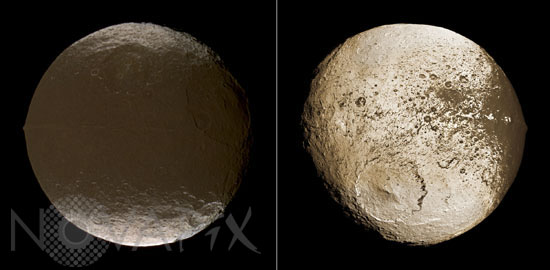Photo Agency - Astronomy - Space - Nature

Saturn's moon Iapetus seen by Cassini spacecraft
author: Nasa/JPL/SSI/Novapix
reference: a-sat05-21004
Image Size 300 DPI: 21 * 10 cm
These two global images of Iapetus show the extreme brightness dichotomy on the surface of this peculiar Saturnian moon. The left-hand panel shows the moon's leading hemisphere and the right-hand panel shows the moon's trailing side. While low and mid latitudes of the leading side exhibit a surface almost as dark as charcoal, broad tracts of the trailing side are almost as bright as snow. The dark terrain covers about 40 percent of the surface and is named Cassini Regio. The names of the bright terrain are Roncevaux Terra (north) and Saragossa Terra (south).
On both hemispheres, the dominant landforms are impact craters. The largest known well-preserved basin on Iapetus, called Turgis, has a diameter of about 580 kilometers (360 miles). It lies at 17 degrees north latitude, 28 degrees west longitude at the eastern edge of the dark Cassini Regio and is visible on the right side of the left-hand panel. The prominent basin on the southern trailing side (at the lower left of the right-hand panel) is Engelier. Engelier is located at 41 degrees south latitude, 265 degrees west longitude, and has a diameter of about 504 kilometers (313 miles). Its formation destroyed about half of Gerin, another large basin on Iapetus. Gerin is located at 46 degrees south latitude, 233 degrees west longitude, and has a diameter of about 445 kilometers (276 miles). Tortelosa Montes, a part of the giant equatorial ridge that was discovered in Cassini images on December 25, 2004, is visible in the left panel as a thin line within Cassini Regio, and as a tall prominence at the western limb. It continues onto the trailing side (right side of right panel), where the bright western flanks of the Carcassone Montes appear as dominant bright spots within the western edge of Cassini Regio. North on Iapetus is approximately up in the images. Iapetus has a diameter of 1471 kilometers (914 miles). The right-hand panel shows a mosaic of 60 different images, obtained on September 10, 2007. The left-hand panel is a color composite of three images obtained through infrared, green and ultraviolet spectral filters (centered at 752, 568 and 338 nanometers, respectively) by Cassini's narrow-angle camera on Dec. 27, 2004. The view was acquired at a distance of approximately 717,000 kilometers (446,000 miles) from Iapetus and at a sun-Iapetus-spacecraft, or phase, angle of 22 degrees.
Keywords for this photo:
2004 - 2007 - ASTRONOMY - CASSINI - GLOBAL VIEW - IAPETUS - IMPACT CRATER - SATELLITE - SATURN'S MOON -
Contact : Stéphane Aubin +33-(0)9-51-26-53-76
© Novapix - All rights reserved


